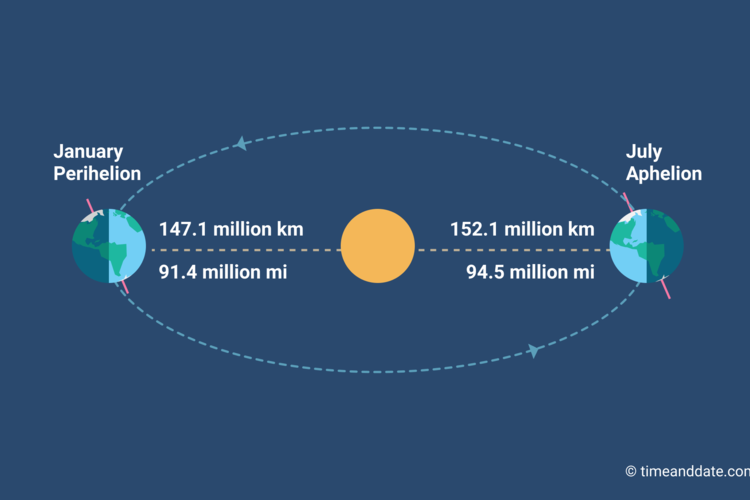Lucky us
Consider an American Football field as a model for space, 100 yards from end zone to end zone. Our Sun would be roughly the size of a yoga/exercise ball chair (if you can't picture that think of a large beach ball) on one end zone. The Earth would be roughly the size of a pea located all the way on the other end zone. Let's make this interactive... put the pea in your belly button ("He's got the whole world / In his belly button...") and lay down on the end zone. Assuming an average adult, in this scenario the moon would be about the size of the pupil in your eye, and would be about as far from your belly button as your heart. If you are laying down with your belly button (the Earth pea) on the end zone, feet towards the Sun, your feet would be too close to the sun for life to exist. Roughly the length of your leg is how close we are to the edge of "too hot for liquid water" - I find that incredible.The Earth's orbit around the sun is elliptical, but it only varies by a couple percent from spherical... at our closest in January we are 91.4 million miles from the Sun and in July we are 94.5 million miles away. If our orbit was spherical and moved in/closer to, say 88-90 million miles, the Earth would have no life on it. Not much wiggle room!
 |
| Earth's orbit around the sun, from reference 5 |
As our sun ages and grows, earth will eventually be closer to it than the habitable zone... but that's apparently about a billion years from now so I'm not going to lose any sleep about that.
Are there any other Goldilocks out there?
Thinking a bit more about the uniqueness of our earth and the vastness of space, the next closest solar system is thought to be Alpha Centauri. In this ridiculous football field analogy, given our nearest neighbor is 300,000 times the distance from the earth to the sun, then 17,000 miles away (90 million feet), we would have another exercise ball chair - slightly larger. That's more than twice the diameter of the actual size Earth. I'm not really sure how else to visualize that.... one way might be to use the circumference of our home planet, actual size... So let's put the our football field around the equator, say in Nairobi, Kenya. If you were to head east, you would need to go across the Indian ocean (wave to Asia on your left), island hop through Indonesia (Australia on your right), cross the enormous Pacific ocean, give yourself a pat on the back for reaching the Americas at the Andes, cross the entire Amazon, and find yourself somewhere around the edge of the Atlantic ocean before reaching our next large beach ball possibly on a sunny day in Ipanema. Then there you would get another football field and a zone about the width of a volleyball or soccer field where liquid water might be able to exist. I honestly can't even fathom that. If there's anybody else out there, they are a looooooooong way away, and they need a lot of luck and a lot of variables to be aligned for them to exist. On that entire journey, by the way, you would essentially pass through complete nothingness. A few asteroids here and there, but on that scale, they'd be invisible tiny little grains of sand that you wouldn't notice at all.Ok, there's a quick minute that melts my brain about us and our nearest neighbor. 2 stars. There are apparently up to 400,000,000,000 stars in the Milky Way galaxy alone. There are anywhere from 100,000,000,000 - 2,000,000,000,000 galaxies in the Universe. I'll let you ponder that on your own, aside from to say that there are more stars in the universe than grains of sand on all the beaches on the entire earth. Think about our sun as one of those grains of sand one day on your next vacation...
It it unfortunate that people don't (literally can't?) really appreciate how unique our planet - and life on its the ability to exist - is.
References:
- https://joshworth.com/dev/pixelspace/pixelspace_solarsystem.html
- https://www.youtube.com/watch?v=zR3Igc3Rhfg
- https://www.sciencefocus.com/space/how-much-closer-to-the-sun-could-earths-orbit-get-and-still-be-habitable/
- http://curious.astro.cornell.edu/ask-a-question/39-our-solar-system/the-earth/other-catastrophes/58-how-big-a-change-in-the-earth-s-orbit-would-be-required-to-destroy-all-life-intermediate
- https://www.timeanddate.com/astronomy/perihelion-aphelion-solstice.html
- http://www.astro.sunysb.edu/fwalter/AST101/habzone.html
- https://www.latimes.com/science/sciencenow/la-sci-sn-exoplanet-habitable-zone-planet-earth-greenhouse-gas-20131211-story.html
- https://earthsky.org/space/alpha-centauri-travel-time
- https://sos.noaa.gov/datasets/milky-way-panorama-alpha-centauri-label/
- https://www.universetoday.com/106725/are-there-more-grains-of-sand-than-stars/
- https://www.space.com/25303-how-many-galaxies-are-in-the-universe.html
- https://www.youtube.com/watch?v=O57DyNMRGY8
- https://www.forbes.com/sites/startswithabang/2018/10/18/this-is-how-we-know-there-are-two-trillion-galaxies-in-the-universe/#2df573175a67